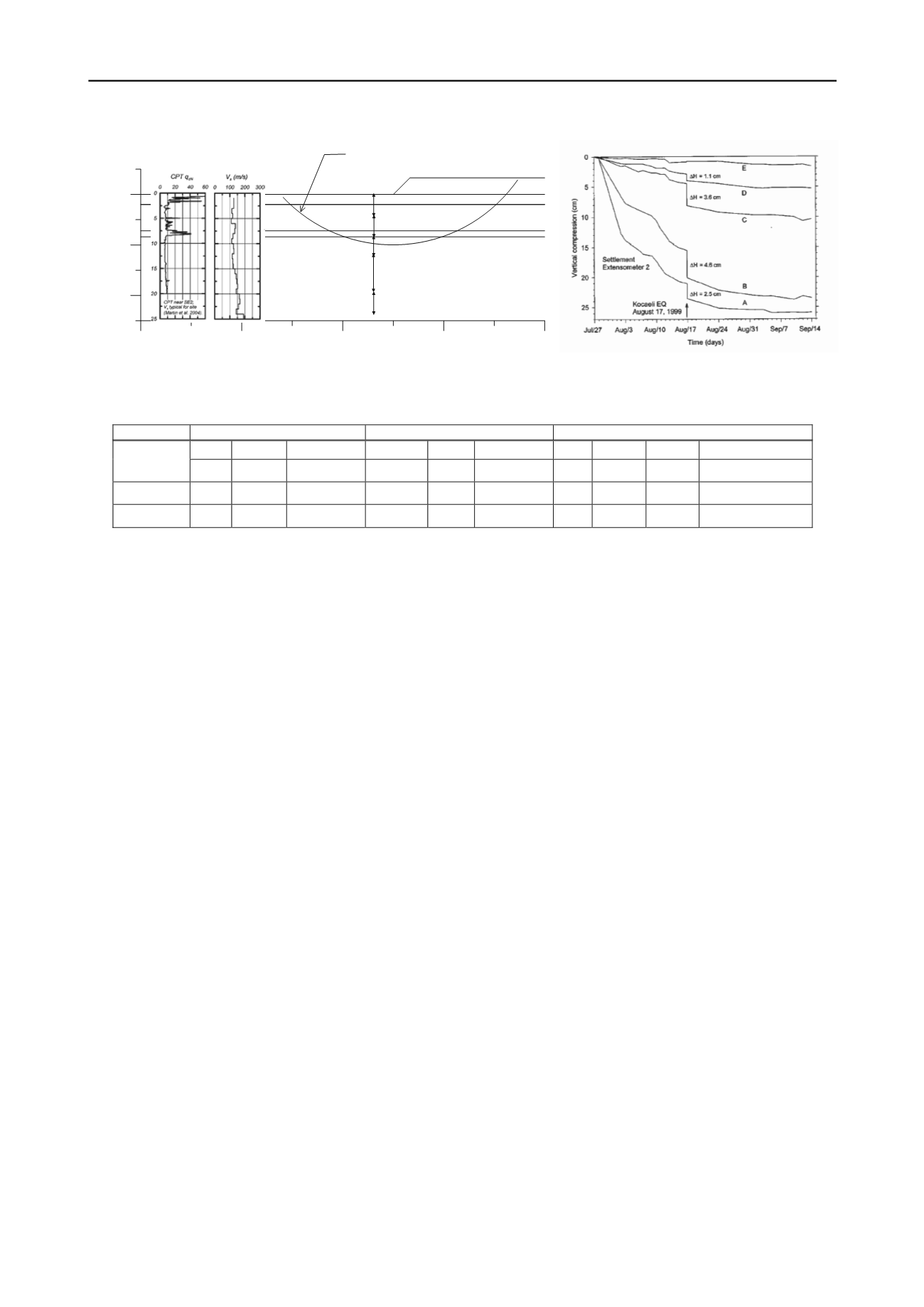
1634
Proceedings of the 18
th
International Conference on Soil Mechanics and Geotechnical Engineering, Paris 2013
(a)
(b)
0
20
40
60
80
-20
-10
0
Depth (m)
NewFill,
=34
OldFill,
=34
ML/CL,PI=10,Su=25 kN/m 2
SM, PI=11,
=32
CH, PI=37, Su=35 kN/m 2
A
B
C
D
E
FS=3.0 (pre earthquake)
FS=1.3 (during earthquake, no strength reduction)
FS=1.0 (during earthquake, 15% strength reduction)
Distance (m)
Figure 6 (a) Subsurface condition at Carrefour Shopping Center (b) Extensometer measurements at Carrefour Shopping Center (Martin et al., 2004)
Table 2. Summary of input parameters and estimated strength loss of two case histories
Case
Seismological information
Site/ soil condition
Estimated results
Mw R
PGA
Vs
OCR
PI
Nc
eff
Strength loss
-
(km)
(g)
m/sec
-
-
(-)
(%)
-
(%)
Berryman
7.0
0.2
0.72
240
3-5
15-30
29
1-3
0.75
25-30
Carrefour
7.4
5
0.24
120
1
10-37
28
0.3
0.88
10-15
Bearing-capacity was evaluated using a slope stability
approach before the earthquake and during the earthquake with
a pseudo-static type analyses. The failure surface was
constrained to a depth of 10 m below the ground surface
because extensometer measurements indicate that large
deformation occurred at this depth. As shown in Figure 6, the
FS for slope stability is 3.0 pre-earthquake and becomes 1.0
with a 15% estimated strength reduction (as listed in Table 2),
compared to 1.3 without considering strength loss during the
earthquake. The result suggests that the soil layer exhibited
strength loss and that the amount of strength loss simply
estimated by the proposed procedure leads to an analysis
outcome consistent with the field observations.
7 CONCLUSION
In this paper we present an analysis procedure to estimate
cyclic softening of saturated clays under seismic loading.
Unlike common liquefaction potential analysis procedures that
use a stress-based approach, the procedure uses a strain-based
approach to estimate cyclic softening and associated strength
loss. The procedure has two main components: (1) estimation of
the shear strain amplitude and the equivalent number of uniform
strain cycles within the soil mass induced by an earthquake
event; and (2) estimation of the softening and associated
strength loss within the soil given the effective shear strain
amplitude and the equivalent number of uniform strain cycles.
The procedure is successfully implemented in pseudo-static
analysis for analyzing one design case and one field case
history and is found to generally provide reasonable, first-order
estimates of cyclic softening consistent with the field
observations.
8 ACKNOWLEDGEMENTS
This study was mainly performed by the first author during his
employment with URS Corporation. The authors acknowledge
URS’ support. The authors also would like to acknowledge Mr.
Fidèle Nikiema in translating the abstract into French.
9 REFERENCES
Boulanger, R. W. and Idriss, I. M. (2007) “Evaluation of Cyclic
Softening in Silts and Clays” Journal of Geotechnical and
Geoenvironmental Engineering, Vol. 133, No. 6
Chu, D. B.; Stewart, J. P.; Boulanger, R. W; and Lin P. S. (2008)
“Cyclic Softening of Low-Plasticity Clay and Its Effect on Seismic
Foundation Performance” Journal of Geotechnical and
Geoenvironmental Engineering, Vol. 134, No. 11.
Darendeli, M.B. and Stokoe, K.H. 2001. Development of a new family
of normalized modulus reduction and material damping curves,
University of Texas, Geotechnical Engineering Report GD01-1.
Idriss, I. M., Dobry, R., and Singh, R. D. (1978). "Nonlinear behavior
of soft clays during cyclic loading." Journal of the Geotechnical
Engineering Division, 104(CT12), 1427-1447.
Idriss, I. M. and Boulanger, R. W. (2008) Soil Liquefaction during
Earthquakes, EERI EERI monograph.
Kishida, T. and Tsai, C.C. (2012) “Seismic Demand of the Liquefaction
Potential with Equivalent Number of Cycles for Probabilistic
Seismic Hazard Analysis”, submitted to J. Geotech. & Geoenv.
Engrg., ASCE,
Martin II J. R.; Olgun C. G.; Mitchell J. K., and Durgunoglu, H.
T.(2004) “High-Modulus Columns for Liquefaction Mitigation”
Journal of Geotechnical and Geoenvironmental Engineering, Vol.
130, No. 6
Liu A.H., Stewart J.P., Abrahamson N.A. and Moriwaki, Y. (2001).
“Equivalent number of uniform stress cycles for soil liquefaction
analysis” J. Geotech. & Geoenv. Engrg., ASCE, 127 (12), 1017-
1026.
Matasovic, N. and Vucetic, M (1995) “Generlized cyclic-degradation-
Pore- Pressure Generation model for clays” Journal of
Geotechnical and Geoenvironmental Engineering, Vol. 121, No. 1,
June 1.
Mejia, L., Wu, J., Feldsher, T., and Yiadom, A. (2009) “Re-evaluation
of the Seismic Stability of Chabot Dam” Proceedings of Annual US
Society on Dams Conference, USSD 2009, Nashville, TN.
Tokimatsu K. and Seed H.B. (1987.) “Evaluation of settlements in
sands due to earthquake shaking”, J. Geotech. Engrg., ASCE,
113(8), 861-878.
Tsai, C. C. and Mejia, L. (2011) "A Simplified Procedure to Estimate
Strength Softening in Saturated Clays During Earthquakes" 5th
International Conference on Earthquake and Geotechnical
Engineering, Santiago, Chile
URS (2008) Berryman Reservoir Replacement Foundation Report
Prepared for East Bay Municipal Utility District


